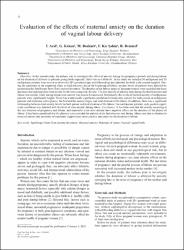| dc.contributor.author | Aral, İlknur | |
| dc.contributor.author | Köken, Gülen Gül | |
| dc.contributor.author | Bozkurt, Murat Fani | |
| dc.contributor.author | Şahin, Figen Kır | |
| dc.contributor.author | Demirel, Reyhan | |
| dc.date.accessioned | 2020-12-19T20:03:32Z | |
| dc.date.available | 2020-12-19T20:03:32Z | |
| dc.date.issued | 2014 | |
| dc.identifier.citation | Aral, I., Koken, G.G., Bozkurt, M., Sahin, F.K., Demirel, R. (2014). Evaluation of the effects of maternal anxiety on the duration of vaginal labour delivery. Clinical and Experimental Obstetrics & Gynecology, 41(1), 32-36. | en_US |
| dc.identifier.issn | 0390-6663 | |
| dc.identifier.uri | https://hdl.handle.net/11436/3189 | |
| dc.description | WOS: 000343848600007 | en_US |
| dc.description | PubMed: 24707679 | en_US |
| dc.description.abstract | Objective: in the present study, the authors aim to investigate the effect of anxiety during late pregnancy periods and during labour on the duration of delivery in patients giving birth vaginally. Materials and Methods: in the study we included 50 nulliparous and 35 multiparous patients who were at or above the 28th gestational age and followed-up and admitted for birth at the present hospital. During the admission at the outpatient clinic at third trimester and at the beginning of labour, anxiety levels of patients were detected by performing the Spielberger State-Trait Anxiety Inventory the duration of the labour stages of pregnant women were recorded and these durations and maternal state-trait anxiety levels were compared. Results: the trait anxiety of patients both during the third trimester and labour was similar, while during labour state anxiety was seen to be increased. Statistically, the levels of the trait anxiety of multiparous patients were significantly higher. There was a statistically significant correlation between state anxiety for both periods in nulliparous patients and latent and active phases, the first and the second stages, and total duration of the labour. in addition, there was a significant relationship between trait anxiety levels for both period and total duration of the labour. For multiparous patients, only positive significant correlation was detected with the level of state anxiety during labour. Conclusion: It has been seen that the anxiety occurring at the last trimester of pregnancy and labour, and especially acute state anxiety have negative effects on the duration of the phases of labour. It has been considered that the physical care provided for patients at the last trimester and during labour and also evaluation in terms of anxiety and provision of emotional support may cause positive outcomes for the duration of labour. | en_US |
| dc.language.iso | eng | en_US |
| dc.publisher | I R O G Canada, Inc | en_US |
| dc.rights | info:eu-repo/semantics/openAccess | en_US |
| dc.subject | Spielberger State-Trait Anxiety Inventory | en_US |
| dc.subject | Maternal anxiety | en_US |
| dc.subject | Duration of labour | en_US |
| dc.subject | Normal vaginal birth | en_US |
| dc.title | Evaluation of the effects of maternal anxiety on the duration of vaginal labour delivery | en_US |
| dc.type | article | en_US |
| dc.contributor.department | RTEÜ, Tıp Fakültesi, Cerrahi Tıp Bilimleri Bölümü | en_US |
| dc.contributor.institutionauthor | Şahin, Figen Kır | |
| dc.identifier.volume | 41 | en_US |
| dc.identifier.issue | 1 | en_US |
| dc.identifier.startpage | 32 | en_US |
| dc.identifier.endpage | 36 | en_US |
| dc.relation.journal | Clinical and Experimental Obstetrics & Gynecology | en_US |
| dc.relation.publicationcategory | Makale - Uluslararası Hakemli Dergi - Kurum Öğretim Elemanı | en_US |


















